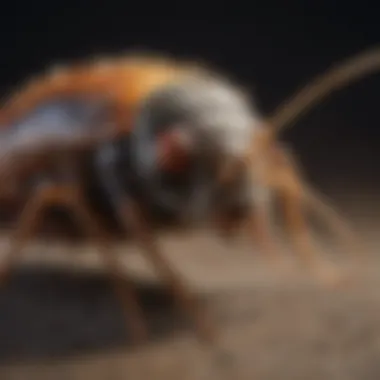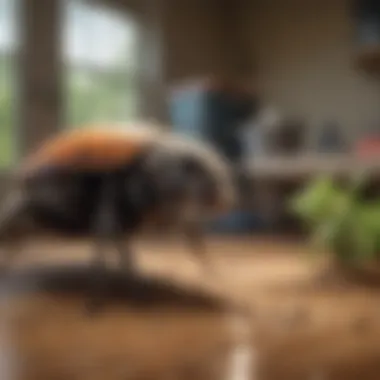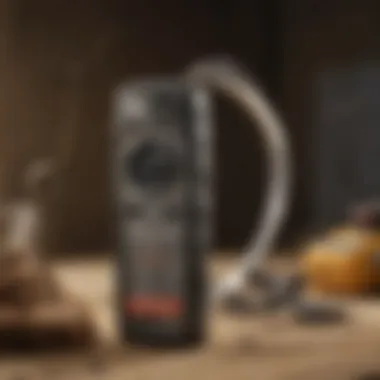Effective Pest Control in Kinston, NC: A Comprehensive Guide


Intro
Pest control is a significant issue for many homeowners in Kinston, NC. The unique climate and geography of this area create a conducive environment for a variety of pests. Understanding how to manage these pests effectively is critical to protecting homes, gardens, and overall quality of life. This guide aims to provide detailed insights into pest control strategies specific to Kinston, including identification methods, preventative techniques, and sustainable solutions.
Understanding Pests
Definition of Pests
Pests refer to organisms that are considered harmful to crops, livestock, or human health. This includes insects, rodents, and weeds. Each type of pest poses different threats and can cause varying degrees of damage. In Kinston, common pests include ants, termites, roaches, and rodents, all of which can compromise both residential and agricultural settings.
Importance of Pest Identification
Identifying pests is the first step in an effective control strategy. Misidentification can lead to inappropriate treatment, which may not resolve the issue or, worse, exacerbate it. Proper identification allows homeowners to choose the right methods for a specific pest problem. Educating oneself on the characteristics of local pests can dramatically affect the success of pest management efforts.
Prevention Techniques
Home and Garden Preventative Measures
Preventative measures are essential to stop pests before they become a problem. Simple actions can greatly reduce the likelihood of infestations:
- Seal entry points: Ensure that windows, doors, and any gaps in your home’s foundation are properly sealed.
- Maintain cleanliness: Regularly clean kitchens and dining areas to remove food remnants that attract pests.
- Manage waste: Secure trash bins with tightly fitted lids and compost any organic waste correctly.
- Landscape wisely: Remove debris and keep gardens well-maintained to eliminate hiding places for pests.
Seasonal Prevention Tips
Different pests become active at various times of the year. Awareness of seasonal patterns allows homeowners to take proactive measures. For instance, in spring, checking for signs of termites becomes crucial as they often swarm at this time. In late summer, ant colonies may look for food sources indoors. By understanding these cycles, homeowners can prepare accordingly and implement preventive measures beforehand.
Eco-Friendly Pest Control Solutions
Overview of Sustainable Practices
With growing concerns about the environment, adopting eco-friendly pest control methods is becoming increasingly important. These methods focus on minimizing harmful impacts while effectively managing pest populations. Integrated pest management (IPM) integrates multiple strategies, including biological control, habitat manipulation, and cultural practices, to minimize reliance on chemical pesticides.
Natural Remedies and Their Effectiveness
Natural remedies can offer effective pest control solutions. Some widely used options include:
- Diatomaceous earth: This natural substance can be a powerful tool against crawling insects, as it damages their exoskeletons, leading to dehydration.
- Essential oils: Oils such as peppermint and eucalyptus can act as natural repellents for various pests.
- Vinegar: A simple mixture of vinegar and water can deter ants and other insects when applied to entry points.
Understanding the Pest Control Landscape in Kinston
Pest control is a crucial aspect of maintaining a healthy living environment. In Kinston, understanding the pest control landscape can help housewives and homeowners take proactive measures against pest infestations. It’s not just about eradicating pests; it is about prevention and sustainability as well. Knowledge of local pest tendencies empowers residents to address issues before they escalate.
Overview of Pest Control Practices
In Kinston, there are several pest control practices employed by homeowners and professional services. These practices include both preventive measures and reactive strategies. Homeowners often engage in regular inspection and maintenance routines. This includes sealing cracks, keeping spaces clean, and removing standing water.
Professional pest control services utilize methods like chemical treatments, baiting systems, and thermal remediation. An informed approach considers the ecology of local pests, weighing the effectiveness of various strategies against their environmental impact.
- Regular inspections help in early detection.
- Cleaning and sealing entry points can prevent many infestations.
- Chemical treatments may be necessary, and understanding them is key.
- Ecological considerations must guide pest control choices.
Sustainable practices are becoming more prominent. Integrated Pest Management or IPM is one approach that combines different strategies for effective control. By understanding the pest control landscape, homeowners can implement correct measures tailored to Kinston's geographic and climatic conditions.
Historical Context of Pest Issues in Kinston
The historical context of pest issues in Kinston is essential to understand current challenges. The warm, humid climate of eastern North Carolina has always made Kinston a suitable environment for various pests. In the past, agricultural activities have led to significant pest problems, especially with insects that threaten crops.
Changes in land use and urban development have shifted pest dynamics over decades. As Kinston grew, so did the presence of urban pests. Rodents and insects adapted to the human environment, creating challenges for residents. Historical records show patterns of pest outbreaks that coincide with periods of environmental change or economic hardship.
Awareness of these historical factors can provide insight into current pest management practices. Understanding past issues helps identify solutions for both short-term and long-term insect control in homes, thus reducing reliance on chemicals and promoting healthier living.


"Knowledge of pest history is as important as understanding current pest behaviors and challenges. It shapes future strategies and empowers residents in Kinston to anticipate and manage pest-related problems effectively."
This background equips homeowners with the information needed to make informed decisions, fostering a responsible approach to pest control that is aware of both immediate and ecological consequences.
Common Pests Found in Kinston
Understanding the common pests in Kinston is crucial for effective pest management. The region has its unique set of challenges, stemming from its climate and surrounding environment. When residents are informed about the specific pests they may encounter, they can take proactive steps in preventing infestations and minimizing damage.
Common pests not only affect homes but also impact local ecosystems. Awareness helps in choosing the right prevention strategies that protect both properties and maintain the balance of nature. For instance, anticipatin' the seasonal patterns of pest activity allows homeowners to adjust their maintenance and prevention efforts accordingly.
Moreover, recognizing these pests can also reduce health risks associated with infestations. Many insects and rodents can transmit diseases or cause allergic reactions. Therefore, identifying common pests plays a key role in safeguarding health.
Rodents: Identification and Impact
Rodents are among the most problematic pests in Kinston. House mice and roof rats are common species. These animals are agile and can squeeze through small cracks, making it easy for them to invade homes. Rodents can cause significant damage to insulation, wiring, and wood structures, leading to costly repairs.
Identifying their presence often involves looking for signs such as droppings, gnaw marks, and nests. Also, they can carry diseases like hantavirus and salmonella, posing health risks for families. Recognizing these issues is essential for effective eradication and prevention.
Insects: Types and Threats
Insects constitute a diverse group of pests, each presenting unique challenges. Their presence can not only damage property but also impact wellbeing.
Ants
Ants are social insects that can form colonies in and around Kinston. They are attracted to food sources, which makes kitchens and pantries vulnerable. Some species can cause damage, while others may simply be a nuisance. Their high adaptability is a significant characteristic, making them resilient against certain control measures. Understanding ant behavior helps in deploying effective eradication techniques.
Termites
Termites pose a severe threat to wooden structures. Their ability to consume wood can lead to substantial damage before the homeowner even realizes there is a problem. Subterranean termites, in particular, are common in the area. One key characteristic of termites is their colony structure, where they work tirelessly to gather and process food underground.
Regular inspections of wooden parts of buildings can help detect early signs of termite activity. Ignoring these signs could lead to major structural damage, emphasizing the need for preventive measures.
Roaches
Roaches are another common pest that can invade homes. They thrive in warm, humid environments, often finding refuge in kitchens and bathrooms. The presence of cockroaches can indicate unsanitary conditions. They are known to spread diseases, making removal a priority. Recognizing symptoms of a roach infestation involves looking for droppings or egg cases.
Other Pests: Snakes and Birds
In Kinston, both snakes and birds may also require attention, though they are often overlooked compared to insects and rodents. Snakes, while generally beneficial for controlling rodent populations, can cause alarm for some residents. Identification is key, as most snakes in the area are harmless. Education about their ecological role can foster more peaceable coexistence.
Birds, particularly pigeons, can become a nuisance when they establish nesting sites near homes. Their droppings can damage property and create health hazards. Taking steps to prevent nesting can help minimize these issues.
Identifying Pest Problems
Identifying pest problems is crucial for maintaining a healthy living environment. In Kinston, where various pests are prevalent, understanding how to spot early signs of infestations can prevent larger issues down the line. These infestations can damage homes, destroy property, and expose occupants to various health risks. By recognizing patterns of pests early, homeowners can take proactive measures to address these concerns before they escalate.
Signs of Infestation
Recognizing the signs of infestation is the first step in pest management. Common indicators include:
- Droppings: Small pellets or droppings can point to rodents or insects. Pay attention to the location and size of these droppings as they help identify the pest type.
- Noises: Sounds of scratching or scurrying within walls may signal rodent activity. Listen for these noises, especially during quiet hours.
- Nesting Materials: Finding shredded paper, fabric, or leaves may suggest nesting, particularly from rodents.
- Damaged Goods: Holes in food packaging or chewed wood can indicate the presence of pests like termites or mice.
- Visible Insects: Spotting insects such as ants or roaches can be a clear sign of an infestation.
Regular inspections of your home, especially in corners and hidden spaces, can help reveal these signs.
Health Risks Associated with Infestations
Pest infestations carry significant health risks that homeowners should not ignore. Rodents and insects can transmit diseases through their droppings, urine, and bites. Here are some common health concerns:
- Asthma and Allergies: Cockroach droppings can trigger asthma symptoms and allergic reactions in sensitive individuals.
- Hantavirus: This virus is transmitted through rodent droppings and urine, posing serious health risks.
- Salmonella: This bacteria, often associated with rodents, can contaminate food and surfaces, leading to gastrointestinal illnesses.
- Lyme Disease: Ticks can transmit this serious disease through bites, making it essential to monitor for pests.
Awareness of these health risks provides a solid reason to be vigilant in pest identification and control.


When to Seek Professional Help
Determining when to request professional assistance in pest management can be a challenging task. Certain situations warrant immediate expert attention:
- Severe Infestations: If you observe large numbers of pests, such as a colony of ants or a rodent nest, it’s time to contact a pest control expert.
- Health Concerns: If any occupants in the house experience health issues potentially related to pests, immediate professional help is necessary.
- Ineffective DIY Methods: If your attempts at pest control fail and pests continue to thrive, professional intervention may be required.
- Structural Damage: Signs of structural damage, particularly from termites or other wood-destroying insects, should prompt a call to professionals immediately.
Professional pest control services have the tools and knowledge to address infestations effectively.
"An early response to pest problems can save time, money, and health concerns in the long run."
Becoming knowledgeable about identifying the signs of pests and understanding associated risks can empower homeowners in Kinston, NC, to maintain a pest-free living environment.
Preventive Pest Control Measures
Preventive pest control measures are critical in maintaining a healthy living environment. These practices not only reduce the likelihood of infestations but also help in minimizing the need for chemical treatments. Implementing preventive measures can save homeowners both time and money in the long run. Furthermore, understanding how to proactively address potential pest issues empowers residents to take charge of their homes.
Home Maintenance Tips
Maintaining a home is one of the best ways to prevent pests. Regular inspections can help identify problem areas before they become significant issues. Here are some essential home maintenance tips:
- Seal cracks and crevices: Inspect the exterior walls of your home for any gaps which may allow insects and rodents entry. Use caulk or sealant to fill these openings.
- Keep drains clean: Regularly check and clean your gutters and drains. Standing water can attract various pests, especially mosquitoes.
- Store food properly: Make sure all food items are stored in airtight containers. This simple practice helps to deter ants, cockroaches, and other pests.
- Dispose of trash frequently: Empty your trash bins regularly and use lids to keep pests away.
- Maintain landscaping: Trim back plants and remove debris that might provide indoor access for pests.
Following these tips can significantly reduce pest attraction to your home.
Gardening Practices to Deter Pests
Gardening is an essential aspect of many homes in Kinston. Utilizing specific practices can help deter pests in your garden, leading to a more enjoyable outdoor space. Some useful gardening tips include:
- Choose resistant plant varieties: Selecting native plants or pest-resistant species can minimize pest problems.
- Companion planting: Some plants can naturally repel pests when grown alongside others. For instance, marigolds can deter nematodes and aphids.
- Natural pesticides: Instead of chemical sprays, consider using natural solutions such as neem oil or insecticidal soaps that are less harmful to beneficial insects.
- Encourage predators: Create an inviting environment for birds and insects such as ladybugs that prey on common pests. Installing birdhouses or planting flowering plants can help.
- Regular monitoring: Keep an eye on your plants for early signs of pest damage. Early detection can make remediation much easier.
Employing these gardening practices will foster a healthier ecosystem in your yard.
Community Efforts in Pest Prevention
Community involvement is valuable in effective pest control. Collective efforts can lead to a significant reduction in pest populations in Kinston. Here are ways communities can work together:
- Host community workshops: Educating neighbors on preventive measures and pest identification helps create awareness and encourages shared responsibility.
- Neighborhood clean-up events: Organizing clean-up days can ensure that common areas are free from debris, reducing the habitat for pests.
- Information sharing: Utilizing platforms like social media to share pest-related issues and solutions can mobilize community members and spread helpful knowledge quickly. Platforms such as reddit.com can be effective for this.
"Knowledge shared within the community can lead to more effective pest management strategies."
- Establish a pest control task force: Working together with local pest control services can facilitate coordinated responses to emerging pest problems.
Sustainable Pest Control Solutions
Sustainable pest control solutions have gained prominence in recent years as environmental consciousness rises. The need for effective pest management while minimizing harm to ecosystems is crucial. In Kinston, these methods contribute to healthier surroundings and lessen the reliance on chemical treatments. This approach promotes not just the eradication of pests but also the preservation of beneficial insects and the surrounding environment. By implementing sustainable solutions, homeowners can achieve a balance between pest control and ecological responsibility.
Organic Pest Control Options
Organic pest control options offer a safe alternative for managing pests without introducing synthetic chemicals. Homeowners can use natural ingredients that are less harmful to people and pets. Common methods include:
- Neem oil: Derived from the seeds of the neem tree, it disrupts the life cycle of insects without harming beneficial organisms.
- Diatomaceous earth: A powder made from fossilized algae that dehydrates and kills various insects.
- Soap sprays: Simple mixtures of water and soap can suffocate soft-bodied insects.
These organic methods not only reduce environmental impact but also foster safer living spaces. In Kinston, adopting organic solutions can effectively manage pests while aligning with eco-friendly practices.
Integrated Pest Management (IPM)
Integrated Pest Management (IPM) is a comprehensive approach to managing pests that combines various strategies. This method considers the life cycle of pests, their environmental needs, and the potential impact on the ecosystem. Key aspects of IPM include:
- Monitoring: Regular inspections to identify pest problems before they escalate.
- Prevention: Implementing measures to reduce the likelihood of pest infestations, such as sealing entry points.
- Control strategies: Using a mix of biological, physical, and chemical measures aimed at managing pests with minimal impact on the environment.


Applying IPM principles in Kinston can lead to efficient pest control solutions. It shifts focus from reactive measures to proactive and preventative strategies.
Benefits of Eco-Friendly Buying Choices
Making eco-friendly buying choices influences pest control simplicity and efficiency. Selecting products that use natural ingredients helps protect the environment and reduces human exposure to harmful chemicals. Benefits include:
- Better indoor air quality: Reducing volatile organic compounds (VOCs) in homes leads to a cleaner atmosphere.
- Support for sustainable brands: Purchasing from manufacturers committed to environmentally sustainable practices promotes their growth.
- Long-term cost savings: Eco-friendly options often work effectively and reduce recurring pest problems, leading to more savings over time.
In Kinston, understanding the significance of these choices encourages homeowners to make informed decisions that benefit their health and the environment.
Addressing Common Misconceptions about Pests
Understanding the common misconceptions about pests is crucial in formulating effective pest control strategies. Many people harbor beliefs that may impede their ability to manage pests accurately and efficiently. These myths can lead to unnecessary fears or inappropriate actions, thereby exacerbating pest issues. Therefore, discussing these misconceptions comprehensively allows homeowners in Kinston to adopt informed and effective methods for pest management while also reducing anxiety around pest presence.
Debunking Pest Control Myths
There are plenty of myths about pest control that persist in everyday discussions. Some of the common misconceptions include the belief that all insects and rodents are harmful. In reality, many species play valuable roles in the ecosystem. For instance, beneficial insects like ladybugs help control populations of aphids which can harm plants. Moreover, some individuals think that a clean home will completely prevent pests; however, even the cleanest homes can experience infestations due to various factors, including climate, location, or structural issues.
Another widespread myth is that store-bought pesticides are always effective. While they may offer immediate relief, they often do not solve the underlying problem. Misapplication of these chemicals can lead to health risks, environmental harm, and even increased pest resistance over time. Delaying professional intervention under the pretext of using over-the-counter remedies can also worsen infestations.
By understanding these myths, residents can face pest control proactively instead of reactively. Acknowledging that some pests are harmless and that professional guidance is often necessary can foster more sustainable management practices in Kinston.
Understanding the Ecological Role of Insects
It is essential to recognize the ecological significance of insects within ecosystems. Many individuals overlook the fact that not all insects are pests or threats to human wellness. In fact, many insects are integral to pollination, decomposition, and nutrient cycling.
Key roles of insects include:
- Pollination: Insects like bees, butterflies, and certain beetles are vital for pollinating plants, including agricultural crops.
- Decomposition: Many insects, such as ants and certain beetles, facilitate the breakdown of organic materials, enriching soil health and promoting plant growth.
- Food Source: Numerous species rely on insects as a primary food source, sustaining various animal populations.
Furthermore, understanding their roles can help Kinston residents make informed decisions about pest control. Instead of indiscriminately exterminating insects, homeowners can learn to identify and protect beneficial species, thereby achieving balance in their gardens and backyards.
"Recognizing the ecological roles of insects allows for a more nuanced approach to pest management, fostering both the environment and community health.”
Education becomes a powerful tool in pest control. By addressing misconceptions and embracing a more informed perspective, residents can foster more effective pest management strategies that promote harmony between human activities and nature.
Resources and Assistance in Kinston
When dealing with pest control, having access to reliable resources and assistance is essential. Kinston offers various services and programs that can help residents tackle pest issues effectively. Understanding the resources available can empower homeowners and make pest management more effective. These resources are crucial for raising awareness and encouraging proactive measures against pests in the local community.
Local Pest Control Services
In Kinston, several local pest control companies offer professional assistance. These services specialize in identifying, treating, and preventing pest infestations. When choosing a pest control service, it's important to consider the following factors:
- Reputation: Look for services with positive reviews and satisfied customers.
- Experience: Choose companies that have been in the business for several years. They often have a deeper understanding of local pest issues.
- Methods: Consider the pest control methods used, ensuring they are safe for your family and pets.
- Licensing: Ensure the service is licensed and certified to operate in North Carolina.
Utilizing professional pest control services can lead to more effective results than DIY methods. Experts can provide tailored solutions and long-term prevention strategies, ultimately benefiting the health of your home.
Educational Programs and Workshops
Educational programs play an important role in pest management. They can raise awareness about pest identification and preventive measures. In Kinston, various community organizations and local extension offices offer workshops and informational sessions. Participating in these programs can provide the following benefits:
- Knowledge Gain: Residents learn about common pests and how to identify signs of infestations.
- Networking Opportunities: Meet other homeowners dealing with similar issues and share solutions.
- Hands-On Learning: Many workshops include demonstrations and practical advice that participants can apply at home.
These educational resources are vital, as they empower residents to act knowledgeably and responsibly regarding pest management.
Online Resources and Community Forums
In the digital age, online resources and community forums serve as valuable platforms for sharing knowledge and experiences related to pest control. Kinston residents can benefit from various online tools, including:
- Educational Websites: Resources like the North Carolina State University Extension provide comprehensive information on pest management, including articles and guidelines.
- Social Media Groups: Local Facebook groups often share tips, recommendations, and updates on pest issues specific to the area.
- Reddit Communities: Subreddits related to pest control can offer practical advice and personal experiences, allowing residents to see what has worked for others.
Engaging with these online resources can supplement traditional pest control strategies and foster a sense of community among homeowners.
"Utilizing local resources not only enhances your pest control efforts but also builds community awareness and engagement."
Overall, leveraging available resources in Kinston for pest control can lead to a more successful and informed approach to managing pest-related issues.



